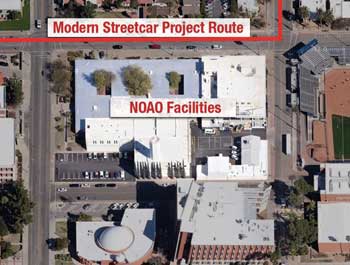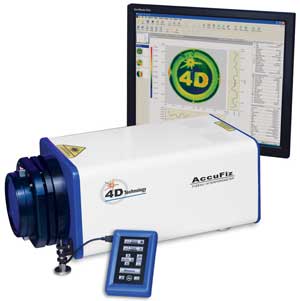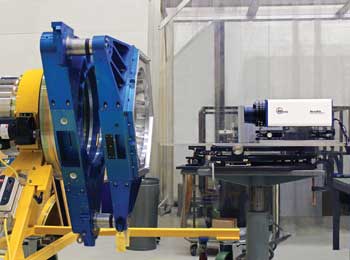Mike Zecchino, 4D Technology Corp.
Dynamic interferometry allows the National Optical Astronomy Observatory’s optics lab to avoid heavy vibration when the city builds a streetcar line nearby.
Sometimes making transit run more smoothly can create a few bumps elsewhere. The Modern Streetcar Project in Tucson, Ariz., was designed to be a sustainable transportation option connecting the city center, the University of Arizona, the Arizona Health Sciences Center and several residential, historic and shopping districts. It sounded good for the community at large, but when personnel at the National Optical Astronomy Observatory (NOAO) heard about the plans, they got worried.
The NOAO’s Optics Shop is on the University of Arizona campus, where it coats, tests and assembles telescope optics and systems, including optics for the 3.5-m WIYN (a consortium comprising the University of Wisconsin, Indiana and Yale universities, and NOAO) Telescope on Arizona’s Kitt Peak. The facility also is situated directly along the streetcar project’s proposed path. So the staff was concerned that vibrations generated by the streetcars – which are scheduled to pass the facility as often as every 10 minutes between 6 a.m. and 11 p.m. – would severely prohibit accurate interferometric measurements within the facility, said Gary Poczulp, NOAO’s Optics Shop and Coating Lab supervisor.

Engineers faced vibration-isolation issues when it was found that the Tucson Modern Streetcar will pass within 100 feet of NOAO’s Optics Shop. Courtesy of ATS Consulting.
The facility already deals with a high degree of ambient vibration, particularly when traffic is heavy on nearby roads. Its large testing rigs are not vibration-isolated, which has required technicians to make measurements during off-hours, with air-handling equipment turned off.
Testing for vibration impact
There was the potential for several research facilities on the University of Arizona campus to be affected by the project, both by vibration and by electromagnetic fields generated by passing streetcars, said Shellie Ginn, program manager for the Tucson Modern Streetcar.
In response to the NOAO concerns, the Modern Streetcar Project hired ATS Consulting, a Pasadena, Calif.-based acoustical consulting firm, to analyze the streetcars’ potential impact. The firm used a technique called vibration propagation testing to simulate the effect of a passing streetcar and placed accelerometers throughout the Optics Shop’s coating and fabrication areas to measure the effects.
The predicted streetcar vibration exceeds the measured nighttime ambient vibration in the low-frequency range when most heating, ventilation and air-conditioning (HVAC) systems are turned off, according to an ATS memorandum. The report also noted that, because the predicted streetcar vibration exceeds the measured nighttime ambient vibration in some frequency ranges, streetcar operations may cause vibration levels that would interfere with interferometer tests in the Optics Lab.1
Several options for mitigating the effects of vibration were proposed and considered, including installing vibration isolation for equipment in the facility and incorporating vibration isolation into the track design. The latter options were found to require massive isolation structures and to be prohibitively expensive. Relocation, a solution employed for another university laboratory located along the route, was not possible for the Optics Shop because of the massive size of its equipment. And, of course, restricting the hours of measurements in the shop would greatly limit the facility’s productivity, while limiting the hours of operation for the streetcar would diminish its effectiveness and jeopardize its fiscal well-being.
Vibration-insensitive testing
NOAO staff suggested a different approach, Poczulp said, and began investigating laser-based instruments that can perform high-precision measurement even in the presence of vibration and motion.
In traditional phase-shifting laser interferometry, which can measure surface shape down to nanometer levels, multiple frames of measurement data are acquired sequentially over hundreds of milliseconds. This acquisition time is very long relative to environmental noise such as vibration and air turbulence, particularly at the nanometer scale. Vibration isolation is possible but can be extremely expensive on the large scale required by the shop’s testing setup.
Over the past decade, several companies have introduced technologies that enable laser interferometry to be used without isolation. In one such method, dynamic interferometry, all measurement data is acquired simultaneously in a single camera frame. The entire acquisition cycle is completed in less than a millisecond, more than a thousand times faster than phase-shifting interferometry. Such fast acquisition time enables measurements to be made despite vibration, without additional isolation. Averaging multiple measurements removes the effect of air turbulence as well.
Dynamic interferometry, therefore, offered a potential solution to streetcar vibration, and with a cost approximately one-tenth that of other proposed mitigation methods.
Several vendors held demonstrations for NOAO and Modern Streetcar Project management to prove the feasibility of the method. “While the city of Tucson people had agreed in principle that a vibration-insensitive interferometer was the way to go, they were interested in seeing how such a piece of equipment would be able to mitigate our anticipated vibration problems,” Poczulp said. The demonstrations successfully showed the technique’s merits, and the instrument was chosen.
Poczulp said 4D Technology’s AccuFiz interferometer was selected because of its small size, which allows the instrument to be moved easily between test stations and facilities, and because of the flexibility of its software, which would enable the system to be used for a variety of future measurement tasks as well as for the current projects at the facility. The interferometer also gave the shop significantly improved resolution and precision compared with its older, traditional measurement equipment.

The AccuFiz interferometer was selected to help the NOAO optics lab overcome a vibration challenge caused by a new streetcar project near the lab. Courtesy of 4D Technology.
Project managers were particularly happy that they found a solution from a local vendor. “What are the chances of finding the solution in Tucson? That usually doesn’t happen,” Ginn said. “We would have found a solution to the vibration problem no matter what, but this option made the most sense. We were able to improve the working environment [at the Optics Shop] and at the same time support the local economy.”
The interferometer was delivered to NOAO in December 2011 and is now in service at the Optics Shop. The system’s vibration insensitivity has exceeded expectations, Poczulp said. “We are able to measure at pretty much any time of day, with HVAC equipment running and trucks coming and going at our dock,” he added.
For one test, the instrument was moved to an adjacent setup to complete optical testing for the One Degree Imager (ODI) instrument destined for the WIYN telescope. Poczulp said that the measurements were completed quickly, and the optical testing, a major milestone for the ODI project, was completed on time.

The vibration-insensitive interferometer at NOAO’s Optics Shop measures components for the WIYN Telescope’s One Degree Imager. Courtesy of NOAO and the Association of Universities for Research in Astronomy Inc.
The streetcar project is now in its construction phase and is expected to have minimal effect on measurements at the lab when it becomes fully operational next year.
Meet the author
Mike Zecchino is the marketing communication manager for 4D Technology Corp. in Tucson, Ariz.; email: [email protected].
Acknowledgments
NOAO is operated by the Association of Universities for Research in Astronomy Inc., under Cooperative Agreement with the National Science Foundation. 4D Technology Corp. develops and manufactures optical metrology instruments for applications in astronomy, aerospace, general optics and other industries.
Reference
1. Analysis of Streetcar Noise and Vibration in NOAO Laboratories. ATS Consulting Memorandum, April 7, 2011.